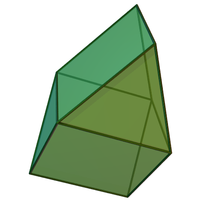gyrobifastigium
Jump to navigation
Jump to search
English[edit]

Etymology[edit]
Noun[edit]
gyrobifastigium (plural gyrobifastigia or gyrobifastigiums)
- A polyhedral solid formed by joining two face-regular triangular prisms along corresponding square faces, giving a quarter-turn to one prism. It is noted for being one of the few regular polyhedra that packs in three dimensions.
- 2011 February, Umang Agarwal, Fernando A Escobedo, “Mesophase behaviour of polyhedral particles”, in Nature materials, volume 10:
- To elucidate this complex correlation, we carried out detailed Monte Carlo simulations of six convex space-filling polyhedrons, namely, truncated octahedrons, rhombic dodecahedrons, hexagonal prisms, cubes, gyrobifastigiums and triangular prisms.
- 2012, Amir Haji Akbari Balou, Thermodynamics of the Hard Tetrahedron System (PhD Dissertation in Chemical Engineering, University of Michigan):
- They observed hard triangular prisms and hard gyrobifastigia to directly transform into their space-filling crystal, while hard truncated octahedra, rhombic.
- 2015, Claudi Alsina, Roger B. Nelsen, A Mathematical Space Odyssey: Solid Geometry in the 21st Century, →ISBN:
- But there are solids constructed from two or more regular prisms that also pack space. An interesting example (with an equally interesting name) is the gyrobifastigium, constructed from two regular triangular prisms. See Figure 1.2.14 for a picture of a gyrobifastigium, and a pattern (called a net) for constructing one.
Translations[edit]
polyhedral solid
|
